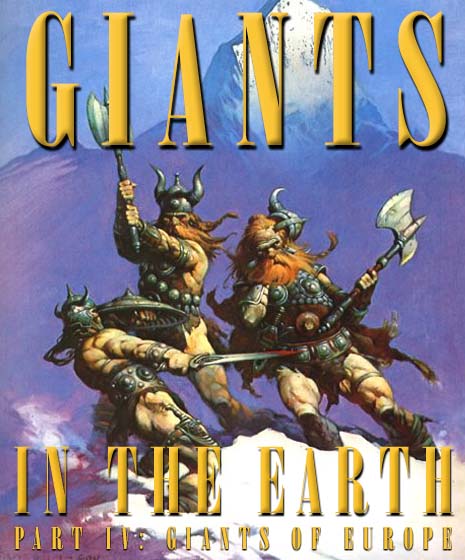
Editorial
|
Press Releases
|
Book Reviews
|
Fragments
NEW! Artifacts: Coral Castle
Grand Canyon II
|
Giants IV
|
Osiria IV
Register
for our Hall of Records Newsletter!
Questions? Comments? Suggestions? Advertising? Press Releases?
Contact us!
Part I: Giants of the Ancient Near East
|
Part II: Giants of the Americas
Part III: Giants of Asia
NEW!
Giants of Europe Discussion Board
(Requires Registration)
Gog, Prince of the West
|
Giants of Europe
|
The Coming War of Gog and Magog
Hunting for Giants
|
Giant Links
|
Books
|
Audio
|
Video
|
Posters
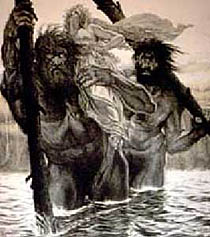
|
|
 pproaching the end of our study of Giants in the Earth, we have discovered so far that our ancient history is not quite what he have been taught in school — or even in Sunday School. From very ancient times, giants have played a dominant role in Earth's history, determining the fate of nations, and even of mankind itself. Yet, our schools have reduced the critical role of the giants to that of a fairytale, lumping them in with religion, folklore, mythology, and everything else that does not fit their sterile secular worldview. And even the church, once the champion of the supernatural, is increasingly selling out to the siren song of secularism, choosing Mammon over God in order to avoid causing offense and losing profitability.
Yet even now the giants of old are threatening to break their ancient bonds and burst back out of obscurity into history, to wage war against heaven one last time in the twilight of their power, before judgment is set and the meek finally inherit the earth. It is that time in human history, the time of the final battle — of the twilight of the gods — that we have now reached. The time is now for the secrets of the ages to be revealed.
pproaching the end of our study of Giants in the Earth, we have discovered so far that our ancient history is not quite what he have been taught in school — or even in Sunday School. From very ancient times, giants have played a dominant role in Earth's history, determining the fate of nations, and even of mankind itself. Yet, our schools have reduced the critical role of the giants to that of a fairytale, lumping them in with religion, folklore, mythology, and everything else that does not fit their sterile secular worldview. And even the church, once the champion of the supernatural, is increasingly selling out to the siren song of secularism, choosing Mammon over God in order to avoid causing offense and losing profitability.
Yet even now the giants of old are threatening to break their ancient bonds and burst back out of obscurity into history, to wage war against heaven one last time in the twilight of their power, before judgment is set and the meek finally inherit the earth. It is that time in human history, the time of the final battle — of the twilight of the gods — that we have now reached. The time is now for the secrets of the ages to be revealed.
So we may more fully understand what is about to happen at this pivotal point of human history, let us now review what we have learned thus far in our hunt to unlock the mystery of the Giants in the Earth:

In
Part I,
we saw that the giants described in
Genesis 6
(and afterwards) were the result of genetic experimentation on the part of a group of heavenly beings — generally known as "fallen angels" — who had come down from heaven to Earth to found kingdoms of their own outside of God's direct control. When this group of 200 powerful demons led by two arch demons named Azazel and Semjaza came down from heaven to Earth, they proceeded to modify the well-ordered Earth that God had created to suit their own whims and desires, despite God's warning them about the consequences of altering His Creation. They then sought to create suitable vessels for themselves that they could use to directly interact with God's Creation, as the animals that God had created were not suitable vessels for higher beings such as themselves. They then decided to create a superior form of animal by manipulating and "improving" the existing animal species, creating the first primitive forms of mankind that preceded our own. We called this early, artificially created, primitive form of mankind homo artificialis — genetically manufactured mankind. These primitive forms — that are known to us today as Neanderthal man, homo erectus, Cro-Magnon man and numerous other forms — were moderately successful, but they were not in balance with nature. Many of them were also very large, even giants, and required a great deal of food just to survive. As a result, these early, primitive forms of mankind overhunted, overfished, and warred upon and even ate each other, causing a great deal of destruction to God's Creation in the process, and ultimately failing as a species.
God was displeased with the meddling of the fallen angels and the wicked and violent behaviors of their giant offspring, so He created His own form of mankind to replace them that was designed specifically to be in balance with His Creation. This new form of mankind, homo sapiens, was not meant to be either warlike or sexually promiscuous like the giants that the fallen angels had created. Homo sapiens, Adam and Eve, were intended to live simply off of the fruit of the land, relying solely on God for their daily needs. In this way, the more efficient homo sapiens would outlast the wicked giants, and inherit the Earth after the self-destructive giants eventually destroyed themselves.
|
|
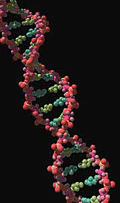
|
|
|
DNA - The Tree of Life?
|
However, the giants successfully tempted Adam and Eve to interbreed with them in order to become "great" like they were, abandoning God's mandate to rely on Him alone and instead following the wicked and warlike ways of the giants that were out of balance with God's Creation. As a result of eating the "fruit" of the Tree of Knowledge — a metaphor for interbreeding with the wicked giants — the pure genetic seed of homo sapiens was compromised, and Eve gave birth to Cain — a human/giant hybrid. In this way, the symbolic meaning of the Tree of Life and the Tree of Knowledge mentioned in
Genesis 3
becomes clear: both "trees" were symbolic of two different types of DNA, where the "Tree of Knowledge" symbolizes homo artificialis, and the "Tree of Life" symbolizes homo sapiens. It is these two "seeds", as prophesied in Genesis 3:15, that continue to battle for dominion over Earth, and will continue to do so until the end of human history and the beginning of the Messianic Age.
Fortunately Adam and Eve were still genetically pure themselves, so they were able to give birth to other sons, including Abel whom Cain slew, and later Seth, through whom the pure line of homo sapiens would manifest. The seed of Seth and the seed of Cain then battled for dominion over Earth until the seed of Cain, which had systematically assimilated or destroyed the seed of Seth, was itself destroyed by the Great Flood, the remnant of the seed of Seth being saved by God from destruction in the ark.
After the Flood had destroyed the first generation of wicked giants, mankind was given a second chance. For a time, mankind followed God's mandate, but eventually the sons of Japheth, the son of Noah, were tempted by the fallen angels once again. The fallen angels used the sons of Japheth as breeding vessels to start breeding a race of giants once again as they had in the world before the Flood, and these giants soon began to make war on both their neighbors and each other. As a result, the wickedness of the giants was once again growing even more rapidly than it had in the world before the Flood, so God slowed their progress by sending the Elamites and their allies to slaughter the giants. This occurred around the time of Abraham, ca. 2000 b.c.
Though their wholesale slaughter had slowed down the progress of the giant infestation, the giants of the ancient Near East had not been completely driven out until the Israelites conquered the land of Canaan and exterminated most of the remnant of the wicked giants, the rest finally being destroyed by King David and his mighty men. Israel finally had driven the giants out of the land of Canaan, but the next generation of giants had not yet been totally defeated, as the original generation of Caucasian giants had conquered not only south into the land of Canaan, but in all four directions: north, south, east, and west.

In
Part II,
we traced in more detail the resurrection of the giants in the world after the Flood. We discovered that the giant breeding program had been reinitiated by the fallen angels in Central Asia, specifically in the region of the Caucasus, from whence their giant offspring had gone forth and conquered towards the four winds. It was there, in the Caucasus, that we theorized that one or both of the leaders of the angelic rebellion, Azazel and Semjaza, had been imprisoned by God. They had been imprisoned there as punishment not only for genetically altering mankind (and other parts of God's Creation), but for showing man how to create weapons and other forms of technology that would have caused mankind to destroy itself, had God not intervened and saved a few in the ark. However, though their power was limited by their imprisonment in the Caucasus, Azazel and Semjaza were still powerful enough to influence events — and people.
|
|
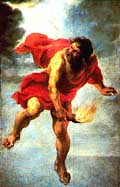
|
|
|
Prometheus stealing "fire" from heaven and giving it to mankind. Fire here is used as a metaphor for technology. Prometheus, a titan
in the Greek myths, was chained to the Caucasus mountains as punishment for giving mankind gifts of technology. Prometheus is likely the
Greek equivalent of Azazel, the "Satan" of the ancient Hebrews.
|
As Noah's sons spread out and multiplied over the face of the Earth, as described in
Genesis 10,
the sons of Japheth migrated north from Mt. Ararat (where the ark had landed), and up through the Caucasus, where Azazel and Semjaza had been imprisoned. It is believed that Azazel, Semjaza and possibly some other wicked angels that had brought destruction to the world before the Flood then began to tempt the sons of Japheth into abandoning God and instead following their false teachings. The sons of Japheth, particularly the sons of Gomer and Magog (Gog and Magog) agreed, and as their "reward" for selling their souls their descendants were genetically manipulated to be much larger and stronger, and were given the secrets of forging metal and developing technologies of war that would help them defeat their enemies. In short, the corruption of the human race by the fallen angels had started once again, this time in the Caucasus.
This next generation of giants was from the line of Japheth, specifically from the descendants of Gomer and Magog, the two eldest sons of Japheth, whom the fallen angels had used as the genetic basis for their giant breeding program. Gomer's descendants, the Gomerians (aka the "Cimmerians") later came into conflict with the descendants of Magog, who later became known as the "Scythians". The Scythians eventually drove the Cimmerians west into Central and Eastern Europe, where they became the "Germans", as they are known to this day. Some of the descendants of Gomer and that of his brethren then continued migrating westward, eventually populating all of Europe. Some of the descendants of Magog, meanwhile, continued migrating eastward, populating Central Asia, China, and India, later migrating across the sea to conquer Australia and New Zealand. Both the descendants of Gomer (Gog) and Magog continued migrating westward and eastward respectively until they finally met up in the Americas, and control of the Americas has regularly changed hands between Gog and Magog ever since.

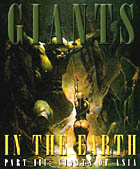
|
|
In
Part III,
we studied the giant sons of Magog in depth. Magog's descendants had driven the sons of Gomer west into Europe, thus becoming the masters of southern Russia and Central Asia, and starting a blood feud that exists between their descendants, the Germans and the Russians, to this day. The descendants of Magog, who later became famous as the "Scythians" and related Central Asian peoples such as the Parthians, later extended their rule south and east into Persia, India and China, eventually conquering as far as Australia, New Zealand and even as far as the Americas.
In Part III we also theorized that the mysterious characters "Gog and Magog" that show up in apocalyptic literature are probably the same as "Gomer and Magog", the name "Gomer" shortened to "Gog" for poetic effect. Also, the name "Gog" may be related to the Greek word gigan, "giant", the use of the word "gog" in both names perhaps underlying the fact that both peoples were gigantic in stature. We also examined how the descendants of both Gog and Magog were given superior size and strength, as well as superior technological warmaking capabilities by the same group of fallen angels, yet the Gomerians and Magogians ended up fighting against each other. To explain this we theorized that this conflict between the Gomerians and Magogians was due to the fact that the two leaders of the angelic rebellion against God, Azazel and Semjaza, were not only fighting against God for control of the Earth, but also against each other. As such, we further theorized that Azazel and Semjaza had each taken control of one of the tribes of
Gomer and Magog, Azazel taking control of the Gomerians and Semjaza taking control of the Magogians. The result of this division was that the two sides of this schizophrenic alliance ended up fighting not only against God, but against each other, using the Gomerians and Magogians as puppets in
their global game of conquest. Left unchecked, the Gomerians and Magogians could, and probably would enventually destroy each other, perhaps destroying
the Earth in the process. This may have been exactly what happened in the world before the Flood, and why God has gone out of His way to keep the giants from rising again.
|
|
|
|
|
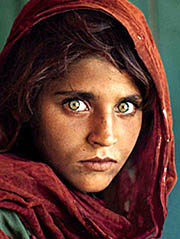
|
|
|
The famous "Afghan Girl", is clear proof of Indo-European influence on the countries of south Asia.
|
|
|
|
The Indo-European descendants of Magog are well attested in the literature of the ancient Persians and Indians as being tall, blonde, bloodthirsty conquerors known for their use of the chariot in battle. Indian history is particularly rife with genocidal invasions by blonde giants. The ancient Persians also record the great height of these people and their great skill in battle, as well as the high degree of sophistication of their weapons and armor. These "Aryan" descendants of Magog invaded throughout Asia and set themselves up as ruling classes over the aboriginal populations, whom they considered to be inferior. And though they eventually died out and/or were assimilated into the native populations, proof exists even today of their presence and influence in Asia by the occasional appearance of blonde hair, blue or green eyes, and Caucasian features amongst the native populations of Asia.

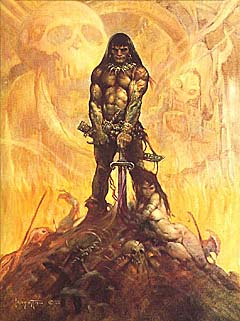
|
|
|
"The Barbarian",
by Frank Frazetta, depicting Conan the Barbarian. Robert E. Howard created his mythical "Conan" character as one of the mysterious
Cimmerian people, the descendants of Gomer, the eldest son of Japheth. Like Conan, the Cimmerians were robbers and plunderers, living by the sword
(and axe) rather than by work or trade. As such, they eventually wore out their welcome, and were eventually defeated by the Romans and other peoples. Though they have long since gone extinct as a coherent people, the genetic remnants of the Cimmerians can still be found all over Europe. Conan the Barbarian is a good example of the archetypal warlike, "lone wolf" character of Western myth, much like the arrogant, warlike "Gog" of apocalyptic literature.
|
|
Whereas Semjaza had used the descendants of Magog to conquer the East, Azazel, the more powerful of the two arch demons, had used the Gomerians to conquer the West. Azazel had genetically altered the descendants of Gomer, and that of Gomer's sons, Ashkenaz, Riphath
(Rapha)
and Togarmah, to be tall, powerful, and highly aggressive giants, and then equipped them with advanced knowledge, weaponry, and martial skills, including the use of the horse, the chariot and, most importantly, the riddle of steel — both the secrets of its manufacture and its proper usage in weapons in armor. Thus equipped, the Gomerians were able to run roughshod over and drive out the smaller, weaker, and ill-equipped descendants of Shem and Ham out of the northern latitudes, and Gomer and all the descendants of Japheth quickly took control of all of Asia and Europe. Using the Gomerians as proxies, Azazel, or "Gog", then became the master of Europe and the West.

Chief among the sons of Japheth in the West were the descendants of Gomer, the "Gomerians", who later became known as the "Cimmerians" by the Greek writers who recorded their histories. The Gomerians had invaded Europe in two different branches, one from the north and east through what is now Eastern Europe, and one from the southeast, through Asia Minor (modern Turkey). DeLoach explains in his classic,
Giants: A Reference Guide from History, the Bible, and Recorded Legend,
Pezron, who traced the Gomarian giants' early entrance into the European provinces, discovered that they came by two routes. The Cimbrians entered from the north. These people ... were better known unto the Greeks by the name of Cimmerians.... I have clearly enough proved that these last were called Sacae, while they continued in the Upper Asia, and I have shewn there were two sorts of them, viz. the more civilized Sacae,
who coalesced into societies in Bactriana and the adjacent countries, and the vagrant and wild Sacae, who were known by the name
"Nomades".... While the Cimbri followed this northern route into Europe, their gigantic cousins, the Gomarian Sacae, advanced along the southern route. Having filled Hircania, Margiana, and Bactriana, these giants soon irrupted into greater Armenia. They afterwards invaded Syria, settled colonies as
far as Arabia, and became neighbors of the Chaldeans.
Yet, for all these expansions, many Gomerians remained unsatisfied.
|
|
|
|
|
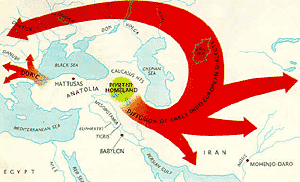
|
|
|
A representation of the route of the "Aryan Invasion", ca. 2000 b.c. The Aryan Invasion Theory posits that a mass migration of peoples took place during the third millennium b.c. and afterwards, moving out from the Caucasus and conquering towards the four winds. One or more waves of Aryan peoples migrated out of the Caucasus region in Central Asia, one half parting from the main body and moving east into Persia, India, and parts unknown to the east (the Magogians), whereas the remaining half (the Gomerians) continued northward and westward to settle Europe. A different group of Gomerians, the "Gomerian Sacae", had proceeded due west through Asia minor instead to conquer southern Europe. Other Gomerians likely invaded south into Canaan, where they were known as the "Amorites", the giants that the Israelites drove out and destroyed by the time of King David, ca. 1000 b.c.
Image from
Armenian Highland.
|
"This nation", explains
Pezron, "besides that it was naturally inclined to war, was moreover, as it hath always been, of a roving, uneasy and ambitious nature. And therefore
the people resolved to make their way yet farther, and to enter into the provinces of western Asia, called "Asia the Lesser." In the first wave of this expansion, they overran Cappadocia and Pontus. Strabo, a native of that country, reports that many of these Sacae afterward settled around the southern shores of the Black Sea.1

|
|

|
|
The "southern" Cimmerians, the "Gomerian Sacae" who had settled in Asia Minor on the southern shores of the Black Sea, were a more "civilized" type of barbarian who tended to found ruling dynasties over the subject peoples that they had conquered, rather than simply plunder them and then leave them in ruins. However, the derisive term "Sacae" applied to the Gomerians indeed refers to the "sacks" that they used to store the booty that they had plundered from those whom they had conquered, so they were by no means completely civilized.
Contrary to our original assertion in
Part I
where we had theorized that the
Amorites
were exclusively the descendants of Ham, it is possible that the Amorites were actually a "melting pot" of peoples like the United States, made up of Semitic, Hamitic, and Japhethitic elements ruled over by Cimmerian giants.
The Amorite dynasty of Babylon was likely Cimmerian in origin, as the southern Cimmerians also controlled extensive areas of the ancient Near East, including parts of Persia, northern Iraq, the Arabian peninsula and Canaan. Babylon was also much like America in that it had an extremely heterogenous population, and very loose moral standards to say the least. The Amorites, or at least their rulers, also were known for having distinctly Caucasian and even Celtic characteristics (the Celts being the later descendants of the Cimmerians), such as being very tall, having blond hair, wearing gold necklaces, or "torques", and riding chariots. So, it is highly probable that at least the ruling class of the Amorites were Cimmerian in ancestry.
Starting during the late third millennium and continuing on and off throughout the second millennium b.c., the southern Cimmerians, as well as having penetrated and conquered deep into Canaan, may have conquered possibly as far as Egypt, where they were known as the
Hyksos
("Shepherd Kings"). The Gomerians and related peoples may also have been the
"Sea Peoples"
that had invaded Canaan, Egypt and North Africa some time later, during the 12th century BC. Or, perhaps, the sea peoples had been conquered and displaced by the Cimmerians, the invasions of the sea peoples being motivated by their need to seek out new lands in which to live.
In either case, the primary conquering thrust of the Cimmerians was to the west, through Asia Minor and into southern Europe.
|
|

|
|
|
The
"Aryan Invasion"
theory illustrated. The western thrust of the southern Cimmerians also included incursions south into
Canaan,
and possibly as far south as Egypt.
Their primary western thrust, however, penetrated as far as Spain and across to western Africa in the southwest, and eventually all of southern Europe. Meanwhile, their northern cousins penetrate Europe from the northeast and conquered Russia, Central Europe, Scandinavia, and the British Isles.
Image from
Archaeology and Language : The Puzzle of Indo-European Origins.
|
|
This "southern front", according to DeLoach, was led by a powerful giant named "Acmon", who was worshiped by his subjects as a god. "The first historians also left evidence that the Gomerian giants who followed Acmon into Asia Minor worshipped him and probably his brother Doeas as gods. Both in Cappadocia and Phrygia, woods and groves were consecrated to this prince, as to a god or hero."2
DeLoach further argues that these giants were probably worshiped as gods by the early Greeks, just as the Magogians who had conquered the
Indians
were also worshiped as gods by the native populace whom they had conquered:
After the Sacae entered into Upper Phrygia, they began calling themselves "Titans" and gave Acmon the title of Most High. The Phoenician historian Sanchoniathon confirms that this prince was addressed as the Most High, or Elion in the Phoenician tongue, and Altissimus in the Greek.... After his death, however, Acmon's people still reckoned him "among the Number of the Gods", and his children continued to offer sacrifices and oblations to him. He was succeeded in all his dominions by his giant son Uranus, who by the Titans was also worshiped as a god. And so it happened that when the Greeks of ancient times came under the dominance of the Titans, they enthusiastically embraced the giants' religious beliefs and also bowed themselves down to Uranus, worshiping him as a Man of Heaven.... From this single family of giant Gomarian princes came "those who have passed for the greatest and ancientest gods of the heathen world".3
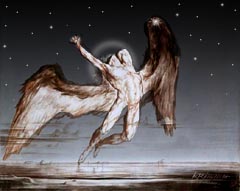
|
|
The character "Lucifer" described in
Isaiah 14
is generally believed to refer both to an earthly king, and as "Satan", a fallen angel that
had been cast down from heaven for his disobedience. This reference may well refer to the giant Cimmerian King Acmon, or one of his descendants.
Image adapted from "Fall of Day", by William Rimmer
from the
Museum of Fine Arts: Boston.
|
It is interesting to note that the worship of trees and idols in groves of trees are specifically forbidden in the Bible as one of the abominations of the Amorites (Exodus 24:12-14, Deut. 7:5). The Cimmerians were likely the ones who left behind all of the megalithic structures in Canaan, such as the stone circle of
Rujim Hiri
and the numerous dolmens that were also typical of the Celts. However, perhaps the most important link between the Cimmerians and the Amorites of the Bible is how Acmon referred to himself as Elion, literally, "the Most High God". Acmon was not only calling himself a god, he was calling himself "God", making him a type of the
Antichrist.
Acmon or one of his descendants may be the wicked king/fallen angel described by Isaiah in his classic diatribe against the mysterious "Lucifer, Son of the Morning":
How art thou fallen from heaven, O Lucifer, son of the morning!
how art thou cut down to the ground, which didst weaken the nations!
For thou hast said in thine heart, I will ascend into heaven,
I will exalt my throne above the stars of God:
I will sit also upon the mount of the congregation, in the sides of the north:
I will ascend above the heights of the clouds; I will be like the Most High.
Yet thou shalt be brought down to hell, to the sides of the pit.
( Isaiah 14:12-15 )
Acmon actually believed himself to be God, the "Most High". Acmon's son Uranus, ("Man of Heaven"), was remembered forever after in Greek myth as one of the elder gods of the Greek race, as was Uranus' son Saturn. Saturn's son Zeus then defeated his father and took over the kingship, forming the Greek pantheon which was kept sacred from then on by both the Greeks and later the Romans, who merely renamed the Greek gods, giving them Romanized names. This "war of the gods", Zeus, Ares, Athena, and so forth against the original group of "titans" including Zeus' father Saturn, later became mythologized so that both the titans and their rebellious offsping, the followers of Zeus, were elevated to the status of godhood. However, though these characters were no doubt extraordinarily tall, powerful, intelligent, and sophisticated, they were never gods, only mortal giants that had been elevated by the superstitious Greeks and Romans to the level of deity. DeLoach explains,
When the Titans of some other provinces learned that Jupiter had dethroned Saturn, and was determined to take over the empire, they formed a confederacy against him. In the ensuing battle, however, Jupiter "ruined the forces of his enemies". Defeated, the Titans retired into Spain and were joined there by Saturn, who came over from Italy. [Jupiter] fought his enemies all in a body, and obtained a complete victory.... The war that Jupiter made against his father occurred some years before the death of Abraham [ca. 1900 BC]. According to the poets and historians, it lasted ten years.... This was the end and fortune of him whom profane historians looked upon to be the origin of the gods, and, as it were, the source of their heathen deities ... they had no knowledge of any god before Saturn.4
So, not only did the giants believe themselves to be superior, they actually believed themselves to be gods, as or even more powerful than God Himself. Thus they set themselves up as god-kings over the populations they had conquered, just as the Nephilim and Gibborim had done in the world before the Flood. And with this next generation of
Rephaim
giants after the Flood came many of the evils that have beset the world ever since.

The "Northern" Cimmerians, those who invaded Europe from the northeast, were also known as "Nomades", having a nomadic, warlike lifestyle based strictly on conquest and plunder. Unlike their southern cousins, they were not at all civilized, living purely by the edge of the sword, though both groups appear to have also been cattle herders and to have had a particular love for horses. The northern group of Cimmerians originally set out for the east, and settled largely in the areas of Bactriana and Margiania, east and southeast of the Caspian Sea. However, in their wanderings they were diverted north by conflicts with the
Magogians,
heading north into what is now modern Russia, later being driven west by the Scythians into Central Europe. Karloukovski explains,
Among the early western peoples, the first human group to emerge at the dawn of history that is identifiable by name rather than by their artifacts are the Cimmerians. The Cimmerians, whose name appears in the Odyssey of Homer, occupied the southern Russian steppe from about 1200 BC. Their civilization, which belongs to the Late Bronze Age, is barely distinguishable from that of other peoples with whom they mingled. From the second half of the 8th century BC, the Cimmerians were replaced by the Scythians. [The Cimmerians lived] in the area north of the Black Sea, but attempts to define their original homeland more precisely by archaeological means, or even to fix the date of their expulsion from their country by the Scythians, have not so far been completely successful. Some authorities identify them with "Thraco-Cimmerian" remains of the 8th-7th century BC found in the southwestern Ukraine and in central Europe; these may perhaps be looked upon as traces of the western branch of the Cimmerians, who, under fresh Scythian pressure, eventually invaded the Hungarian plain and survived there until about 500 BC.5
These "Northern Cimmerians", then, lived out most of their time sacking and plundering the more civilized areas to the south in what would later be known as Media and Persia. However, by the 8th century BC they are seen as migrating north and west, having been driven out by the Scythians all the way to Central Europe, where they remained. And it was from these early Cimmerians, and other descendants of Gomer that had likely intermarried and traveled with them, that the famous Celtic and Gaelic peoples eventually arose. DeLoach explains,
"While tracing their origins for his geography, Ptolemy found that some Sacae also continued to refer to themselves as Gomarians. Those who settled near the Jaxartes in the vast plains that lie between that river and Mount Imaus he identified as the Nomadan Sacae [Northern Cimmerians]. 'These people ... always led a vagrant and savage life, and that was the reason why they were called Nomadan Sacae.... It is very likely the Cimbrians, Cimmerians or Celtic people came from them."6

|
|
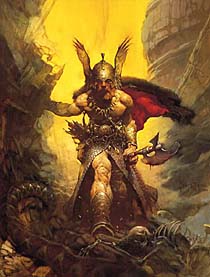
|
|
Though the rather obscure and poorly documented Cimmerians are typically relegated to the vaults of academe, occasionally trotted out as the fodder for swords & sorcery epics such as
Conan the Barbarian,
the Celts
are a very widely known and celebrated people whose roots and antecedents in our present culture have been very carefully researched and documented by both academic and lay scholar alike. Very few, however, have understood the Cimmerian roots of the Celts, which we are about to discover.
The Cimbri or Cimmerians, after making their way overland by the northern route, occupied for a time the country above the Euxine or Black Sea, around the Palus Maeotidis. When they again felt the irresistable urge to roam, they continued westward, eventually settling east of the Rhine, in Germany. They afterward established themselves as far north as Denmark and also colonized Belgium. Acmon's hordes, meanwhile, having advanced by the southern route, first settled in Cappadocia and Galatia, then later on the southern shores of the Black Sea. From there they spread into Gaul, which today we call France, and also across Spain, where they assimilated with the Iberians. Being as prolific in Europe as they had been in Asia, Gomer's oversized children soon overspread a vast territory — from the lands east of the Rhine to the Atlantic and from the Baltic Sea to the coasts of Spain. They also inhabited Switzerland and some northern parts of Italy, especially around the Adriatic.7
The northern Cimmerians conquered and settled the best lands of central, northern, and northwestern Europe, and probably up into Scandinavia and possibly as far as the British Isles and Ireland. There, they supplanted the native, normal-sized, typical homo sapiens peoples, and set up ruling dynasties over them. Meanwhile the southern Cimmerians led by Acmon conquered Asia Minor, some staying behind to become the Galatians, the rest continuing on into southern Europe, through Greece where they were worshiped as gods, to northern Italy, west into southern France and down into Spain where they settled and integrated with the native populations as did their cousins to the north. Also like their northern cousins, they probably made it as far as Britain and Ireland, which would explain some of the numerous invasions and conflicts to be found in Irish history. It was here then, in central and western Europe, that the giant descendants of Gog, the Celts, had made their stand.
|
|
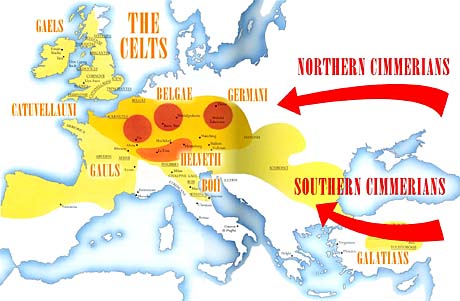
|
|
|
A map of the Celtic world. The Cimmerians invaded Europe both from the northeast and the southeast, the northern Cimmerians becoming the Germani (Germans) and the Belgae (Belgians), whereas the southern Cimmerians became the Galatians in Turkey, the Helvetii and Boii in northern Italy and Switzerland, and the Gauls (French) in France. Later movements of the Cimmerians, and possibly some Scythian immigrants accounted for the Catuvellani of England and the Gaels of Ireland and later Scotland. Click
here
for a larger map.
Map adapted from
The Celts
by John Davies.
|
Modern historians often fail to mention this, but the Celts were indeed giants, adult males typically ranging in height from 6-8 feet tall, with "supergiant"
Og-type giants among them as tall as 12 feet or more. Because of their great size and strength, they easily conquered and formed ruling dynasties over the existing peoples that they had found living in Europe. Just as in the world before the Flood, these resurrected
Nephilim
giants, the
Rephaim
of the Bible, conquered, enslaved, and sometimes even ate the aboriginal inhabitants that they met in Europe. People forget (sometimes on purpose), but there have indeed been giants in the Earth in relatively recent times, the greatest of which were the Celts.
Many historians confirm the great height of these wandering Celts. The ancient Greek historian Pausanias, for example, called them the world's tallest people. Gerhard Herm, his modern counterpart, agrees. He describes them as "blond giants" who struck terror into the hearts of every foe, even in the mightiest of the mighty Rome, which they fought several ferocious wars with and which they once captured, sacked, and burned to the ground. Of course, not all Celts were giants. The average-sized ones probably towered no more than a foot above ordinary men. But their ranks also contained substantial numbers who rose to a gigantic stature. At the utmost divergence from the mean, some Celts even stood to a colossal height, perhaps as tall or taller than the nine-foot-nine Goliath, or even Og, who required a bed over thirteen feet long. Such behemoths, when they first put their ships ashore on Europe's seacoasts, no doubt startled the aborigines. Doing as they did in Asia and Asia Minor, the invading Celts first robbed these lesser mortals, then chased them off the best lands. As they multiplied and required even more territory, they crowded still others out. This fast-expanding nation, according to Strabo, eventually grew to some sixty different tribes — each with its own name. In Upper Asia, Mesopotamia, and Asia Minor, these plunderers were known as the Gomarian Sacae. But once they settled in Europe, the decided to shed their derisive name, which means "robbers", and began calling themselves the Celtae (pronounced "Kelti"), which denotes "potent and valiant men". The Greeks, however, understood them to say Galatai, while their Roman neighbors heard their name as Galli. The aborigines of France, meanwhile called them Gauls. These slightly different pronunciations of course caused different spellings, as the Celtic scholar Henri Hubert explains: "The word which was written down as Keltos in Spain and the neighborhood of Marseilles sounded differently in the ears of the Greeks of the Balkan Peninsula, who wrote it down Galates. But it was the same name.8
The Cimmerians were almost certainly the ancestors of or related to the giants mentioned in the Bible, even calling themselves "mighty men", which in the Hebrew translates to
Gibborim.
The Cimmerians were of the same type of wicked and corrupt "mighty men" that had descended from the Nephilim in the world before the Flood, who had returned to spread chaos and destruction across the face of the Earth once more.
Sihon and
Og
and their Gibborim cohorts were probably related to the Cimmerians who later invaded Europe. It's not impossible that the Cimmerians who invaded Europe were the same giants that had been defeated by
the Israelites
in Canaan and driven out of the ancient Near East. One of the primary evidences for this is the numerous similarities between the Celts and the giants of the Bible, both in size, ethnicity, and cultural customs:
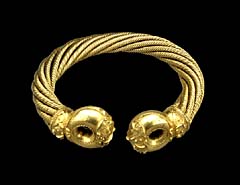
|
|
|
"The Great Torc of Snettisham", ca. 75 BC,
this classic Celtic torque was found in Ken Hill, Snettisham, Norfolk, England, and is considered
to be the most famous object from Iron Age Britain. The torque solves the biblical mystery of the
"Anakim",
literally, "the people of the
necklace", clearly identifying them as the Celts or related peoples who had made an incursion into Canaan in ancient times.
Image from
elf.org.ru.
|
|
Diodorus,
[the Roman historian] says: "The Gauls are terrifying in aspect and their voices are deep and altogether harsh; when they meet together they converse with few words and in riddles, hinting darkly at things for the most part and using one word when they mean another; and they like to talk in superlatives, to the end that they may extol themselves and depreciate all other men." They are also "tall in stature, with rippling muscles, and white of skin, and their hair is blond, and not naturally so, but they also make it their practice by artificial means to increase the distinguishing color which nature has given it. For they are always washing their hair in lime-water, and they pull it back from the forehead to the top of the head and back to the nape of the neck, with the result that their appearance is like that of Satyrs and Pans, since the treatment of their hair makes it so heavy and coarse that it differs in no respect from the mane of horses. Diodorus' account of the way the Celts wore their hair agrees with those representations of the Anakim giants found in the great temple of Abu Simbel. This design depicts "the king contending with two men of large stature, light complexion, scanty beard, and having a remarkable load of hair pendant from the side of the head." Besides the similarity in strange hair styles, the Celts and the
Anakim
both wore torque necklaces. Proof that the Anakim wore them as distinguishing emblems appears in their name. For from 'anaq, the Hebrew word for necklace or neckpiece, came the name Anakim, which means "People of the Necklace". That the tow-headed Celts also adorned their necks with a twisted strip of metal, usually gold or silver, is not only shown by the ancient historians but verified by many archaeological finds. The enemy of course always took note of the Celts' attention-getting neckpieces. And so did the Roman poet Virgil, in these memorable verses: "Golden is their hair, and golden their garb. They are resplendent in their striped cloaks, and their milk-white necks are circled with gold."9
Both the Celts and Anakim were also madly fond of horses and of chariots, practically living on horseback and using chariots constantly, whether for transportation or mere ostentation. The Celtic giants were exactly like their southern brethren who had invaded the land of Canaan in every way. Invading, conquering and destroying, living off the land like parasites and adding no value whatsoever, these giant homo artificialis strains recreated by the fallen angels in the world after the Flood soon came into conflict with God's own creation, homo sapiens.
Just as their cousins in the south had come into conflict with the Israelites, the next generation of giants that had invaded Europe came into conflict with the Romans.
The plundering Celts and Gauls, who initially met only token opposition moving northwest through Greece, soon came into conflict with the powerful Roman Empire. One subgroup of the Celts, the Senones, actually attacked and managed to sack Rome around 387 b.c. Facing off for the first time against 30,000 screaming Goliaths, enraged by grave insults done them by Roman envoys, the Romans were terrified and ran as soon as their lines broke at the Battle of Allia:
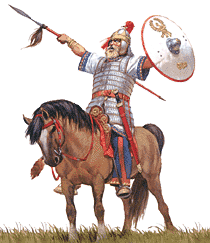
|
|
"Valaris Issues a Challenge to Personal Combat", by Angus McBride. The Celtic giants were rugged individualists who valued individual
accomplishment above all, often calling out champions to fight in single combat before the armies clashed.
Image from
Germanic Warrior.
|
That terrifying July day the Latins would never forget. The great size of the Celts unnerved them. Some of the giants they saw wore chain-wrought iron cuirasses, and some wore only shirts gathered up with belts plated with gold or silver. But many wore no armor nor clothes, preferring instead to go into battle naked. Most, however, wore overlong broadswords slung around the right flanks on chains of iron or bronze. The spears and javelins they brandished give us some idea of their strength. on the spears were affixed iron heads a cubit in length and even more [18-20 inches], and a little under two palms in breadth. [Their swords were] about 96 inches [8 feet] long.... But the terror the Romans felt at the Allia sprang not from the Celt's height and armaments alone. These supermen also assaulted their eyes and ears with fierce looks, deep voices and pre-battle antics. One of these antics called for some of the huge Celtic champions, when they were formed for battle, to step out in front of their lines, brandish their large weapons menacingly at their smaller adversaries and challenge the most valiant among them to single combat. We do not know whether any Romans accepted such a challenge at the Allia, but if they did, according to Celtic custom, each challenger would have then broken forth into a song praising the valiant deeds of his ancestors and boasting of his own high achievements, while at the same time reviling and belittling his opponent, and trying by such talk to strip him of his bold spirit before the combat. Not just the champion warriors, but the whole Celtic army took part in this psychological warfare. Beating their swords rhythmically against their shields, they assailed the enemy's ears with a tumult of almost intolerable sound. The whole country round seemed filled with their exceedingly loud war cries, accompanied by the unceasing blare of innumerable giant boar-headed war trumpeters and horn blowers.10
Unnerved by the great size and boldness of their opponents, and thwarted by a superior tactical move on the battlefield, the Romans fled in terror and Rome itself was nearly defeated. Only by bribing the giants with a "bushel" of gold (approx. 1,000 pounds) were the Romans able to save the city against the Senones and live to fight another day. And that day did come, at the Battle of Telamon, where two legions defeated an army of 70,000 giants. After that day, the giants would forever be on the defense against the mighty Roman legions.
|
|
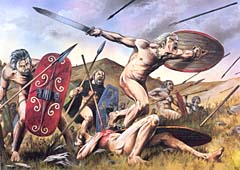
|
|
|
"The Battle of Telamon, 225 BC", by Angus McBride. The Celtic giants were often berzerkers in battle and frequently wore little or no clothing
— not a good combination against Roman arrows, javelins and shield walls bristling with spears.
Image from
Celtic Warrior.
|
Though the Romans had defeated the Senone Celts, they had yet to bring to heel the Germani, "the most Celtic of the Celts". The Germani were made up of several subgroups, including the Cimbri, the Tuetones and the Senones, all of whom the Roman historian Strabo described as living east of the Rhine. "'They differed from Celts of the left bank, he wrote, only by being 'wilder, taller and having yellower hair.' The Romans who lived in Gaul, he goes on to say, called them 'Germani' because they wanted to indicate that they were the 'authentic', the real Celts. Germani means in their language 'genuine' in the sense of the original."11 This makes perfect sense in our paradigm, where we argue that all the Celtic peoples were the descendants of Gomer, from which the name "German" was later derived. In this paradigm, since the Gomerian giants originally emanated from the Caucasus, the closer to the Caucasus you go, the taller the giants will be, as the giants of central and western Europe had been shortened in stature through intermarriage with the local populations they had conquered. As such, the Germanic Cimbri, Teutones and Senones were much closer to the "genuine article", the original Gomerian giants that had migrated north and west from the Caucasus, around the Caspian and Black Seas, to finally end up in Central Europe.
It was against the Germanic giants that the Romans had the most difficulty. The Romans thought that after having dealt with the Gauls, things couldn't possibly get worse. However, "there was, of course, something worse: the Cimbri and the Tuetones, of the Germani, the most Celtic of the Celts. During Caesar's later campaign againt Arovistus, some of his men asked some Gauls at Besancon — who were themselves of great stature — about the Germans. 'They described the Germans', Caesar writes, 'mentioning their enormous physique, their unbelievable valor, and extraordinary military training. The Gauls said that often when they had encountered the Germans they had not been able to endure even the expression on their faces or the glare of their eyes.' Plutarch also portrays them as possessing 'invincible strength and courage: in battle they attack with the force and speed of five and no one can withstand them.'"12
Rome's first real challenge against the Germani came when some 300,000 Cimbri had crossed the Danube and had started migrating southward looking for new lands to possess. Even the giant Gauls were afraid of these Germani, and asked for Roman protection from their hyperaggressive cousins. The first few armies the Romans sent to check their advance were annihilated, and Rome itself was saved only when the Germani decided to head west to find greener pastures in Spain. The desperate Romans then sent for one of their greatest generals, Gaius Marius, who whipped the legions into shape and successfully defeated the Tuetone and Ambrone tribes, even capturing their giant King Tuetobokh, who towered above even the Roman spears. The terrible Cimbri still remained however, but Marius had a plan.
|
|
|
|
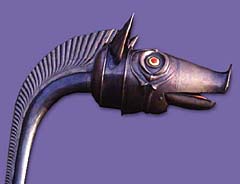
|
|
A
carnyx
war horn, a noisemaker used by the Celtic peoples before going to battle to generate fear and terror in their opponents. This type
of horn is vertically oriented and very tall so that it was visible over the oncoming troops, and the tongue was designed to wag and create a
razzing sound. Look
here
for an example of how it was played, and
here
for a closeup of the tongue, and
click here
to here it played.
Image from
Dexford Community Association.
Music from
The Voice of the Carnyx.
|
On the appointed day, one hundred and eighty thousand Cimbri took up a position in the plain. There they formed a square whose sides measured nearly four miles. Behind them waited their wives and children and the other noncombatants, with their wagons. From the throats of the vast multitude of warriors and even their families now came horrible war cries and shouted singing. Meanwhile, the horn blowers and trumpeters rent the air with their stirring calls to battle. The charioteers began lining up in their appointed places. Some of their splendidly adorned cavalry, which numbered 15,000, pranced about, eager for battle. They wore helmets made to resemble the heads of wild beasts with gaping jaws, and above those rose plumes of feathers. This adornment, as calculated, caused them to appear even more frightful, even more invincible, and even more enormous than they already were.
As the savage hosts worked themselves into a frenzy, Marius and his legionnaires approached from the east, with the sun and wind at their backs. As the Roman legionnaires entered the field, the great Cimbri army set itself into a motion that Plutarch likened to the billowing of a furious ocean at high tide. As was their custom, the bravest of the Cimbri, with blood-curdling yells, led the attack. so that their ranks might not be broken, those in the forefront bound themselves together with iron chains attached to their belts.
This surging tide of blond barbarian giants the Roman foot soldiers attacked first with their javelins. The breech this created allowed the Romans to get inside the Cimbri lines with their swords. As the battle progressed, a big cloud of dust arose from beneath the combatants' trampling feet. The light wind at the Romans' backs blew this dust mostly into the faces of the Cimbri. The hot August sun also began to hinder their sight. To shut out the harsh glare, the heavy-sweating Cimbri warriors now and then lifted their shields at the sun, thus exposing more of their large bodies to the
Romans, who slew them almost at will. After great numbers had been killed and it became evident to those still alive that there was no chance to turn the tide of battle, many brave German giants bound themselves together with chains to fight to the last man. But some sought refuge among their wagons. Then before the Roman's eyes occurred a most unusual scene. The female giants, reports Plutarch, "slew all that fled, some their husbands, some their brethren, others their fathers." With their hands they then throttled their little children and threw them under the racing wheels of retreating chariots or before the pounding hoofs of horses or draft animals. Then they killed themselves.13
|
|
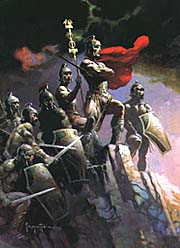
|
|
Thus, yet another attempt by the fallen angels to destroy God's own homo sapiens and rule the world had failed. The Gomerian giants, having failed in their mission to eradicate the lesser forms of humanity and conquer the world, then turned on and destroyed themselves, unable to bear the consequences of their failure. As we discussed in
Part II,
the giants had been bred in such a way to be natural bipolar schizophrenics, so that in order to maintain their sanity it was necessary for them to direct their inner anger outward, in the form of warfare. Thus bred, along with superior speed, size and strength, and given superior technology, the giants would have multiplied and spread like a virus, covering the entire Earth, attacking and killing everyone and who was not like them until, in the end, with everyone else dead, they would kill themselves.
Fortunately, it was not to be. Having defeated the most powerful of the Gomerian Celtic giants, the Romans then began to perfect the fine art of giant killing, which they then applied aggressively in their campaigns against the giants throughout Europe. One by one the tribes of giants fell to the javelins, arrows, spears and stabbing swords of the relentless Roman legions, until the remnant was forced to flee into the dark forests of Europe, or to the fringes of civilization in Scandinavia, the British Isles, Ireland and even the
Americas,
where they integrated with the native populations and waited for their time to rise again.

But the seed of the giants was not destroyed completely. Deep in the depths of the heavily forested strongholds of Europe, the giants began to regroup, and form secretive alliances bound by blood and marriage. Over time, slowly and subtly, the old ways of the giants returned, as they used stealth, secrecy and subversion to slowly take control of the thrones of Europe. And one of the first and boldest of these giants was the infamous Roman emperor, Maximinus Thrax.

Born in AD 173 into a humble family of Thracian (Bulgarian) shepherds,
Maximinus
proved his giant heritage by growing to the enormous height of eight feet six inches tall. And Maximinus was no victim of pituitary disorder — he proved to be an exceptional athlete, as well as being incredibly strong and swift — and power hungry.
Maximinus was first noticed by Emperor
Alexander Severus
in AD 202, during a layover in Thrace on his way back from a tour of Asia. As his son's birthday had come around during his time in Thrace, the emperor sponsored some games for the occasion, matching the local Thracians against his Roman retinue. Maximinus then proceeded to defeat sixteen of the emperor's best in wrestling matches and other feats of strength, which so impressed the Romans that they immediately conscripted him for the army. Maximinus even took the bold step of racing against the emperor's horse, keeping pace with the horse even at full gallop. For this and his exceptional wrestling ability, Maximinus was immediately made part of the emperor's personal guard.
Herodian says Alexander's new commander not only stood to a huge height but possessed a frightening look. Statues of Maximinus and coins minted with his image bear this out. Another Roman historian, Julius Capitolinus, described his hands as so large that he used the bracelet of his wife, Caecilia Pauline, for a thumb-ring. The shoes he wore also measured a foot longer than the footwear of other men. Besides the feats of strength already mentioned above, Maximinus reportedly could, with one blow of his fist, knock out a horse's teeth. On occasion he also demonstrated he could outpull a chariot team. Capitolinus says that he daily ate forty pounds of meat and usually drank six gallons of wine.14
Besides Maximinus' exceptional physical abilities, he also had exceptional intellectual abilities, proving to be a superior leader, strategist and tactician. As a result, he rose rapidly up through the ranks, the emperor soon promoting him to the rank of tribune, senator, and even supreme commander of all the armies of Rome. The soldiers were in awe of him due to his extreme competence, diligence and discipline, and they rarely if ever failed under his leadership. As a result, they soon came to prefer him over their own emperor and, in a sudden coup, assassinated Alexander and placed the purple mantle on Maximinus, effectively crowning him emperor.
However, his sudden ascension to emperor brought out Maximinus' limitations, and his dark side. Although grateful to his men for giving him such a great honor, promising them lavish gifts and double pay, he made a critical mistake in not first checking if Rome could in fact afford to pay such an exhorbitant amount. He made another critical mistake by ransacking the treasury, stealing from the wealthy of Rome, and even pillaging the temples of the gods in order to raise the necessary revenues. Maximinus had essentially made the decision to turn Rome's entire economy towards funding the army, in effect turning Rome into a military state, to the exclusion of all else, even going against the gods.
In reaction to rumors of an assassination plot, Maximinus then turned extremely paranoid, killing not only everyone who involved in the plot, but anyone who opposed or offended him in any way. He even killed off those who had been his early supporters, as they knew him before his ascension to emperor and thus knew "too much". As a result, he began to receive the unflattering informal titles of "the Cyclops", "the Busiris", and even "the wild beast". A song was even composed by his own men that spoke of his death.
Aware of this and his extreme unpopularity in Rome, and since they had never completely accepted him, the Senate used the excuse of a tax revolt in a distant African province to replace the increasingly unpopular Maximinus with one of their own,
Gordian.
Enraged by their betrayal and his now certain doom, Maximinus "behaved like a huge, tormented bear. Convulsed with rage, he dashed himself against walls, threw himself on the ground, bellowed, lashed out at his servants, tried to claw his son's eyes out, and finally drank himself into a stupor."15 He then martialed his forces to put down the tax revolt, but his mutinous army refused and he was finally dispatched by a unit of the Praetorian Guard as he slept.
Maximinus, like all giants, believed himself to be superior to all, including the gods. However, when things had turned against him, his true, beastly nature emerged. Magnifying himself above even the gods of Rome, he attempted to turn the entire economy of Rome towards war, turning Rome itself into a war machine, to the exclusion of all else. Magnifying himself in his own heart, Maximinus attempted to make war against all mankind, and even the gods themselves, but in the end he was cast down and destroyed by his own arrogance — the fate of all giants past, present and future.

"Charlemagne (Charles the Great) was born on April 2, 742 in Northern Europe. 'By the sword and the cross,' he became master of Western Europe."16 Charlemagne had inherited the kingdom of the Franks, modern France, from his father in AD 768 and then proceeded over
the next thirty years building what would remembered by history as "the Holy Roman Empire", which ecompassed at its peak France, Switzerland, Belgium, the Netherlands, half of Italy and Germany, and even parts of Austria and Spain. Unlike his giant cousins, who were pagan through and through, Charlemagne promoted Christianity aggressively throughout his empire, and was even crowned by the Pope himself. His systematic evangelization of the continent of Europe, his enforcement of standard weights and measures throughout the region, and fair treatment of all those in his empire earned him the admiration of all, including those he had conquered. His work to unite Europe formed the basis of the modern European culture.
Charlemagne was a powerful, imposing figure, his height in legend being close to eight feet tall, or "seven times the length of his foot". He was also a great warrior and athlete, and had a strength like that of Maximinus. "In ballads that contemporaries sang in his praise he was so hardy 'that he would hunt the wild bull single-handed, so strong that he felled and horse and rider with the blow of his fist. He could straighten four horseshoes joined together, and lift with his right hand a fully equipped fighting-man to the level of his head."17 Charlemagne was also of the
Merovingian
family, of which we will learn more later.

|
|
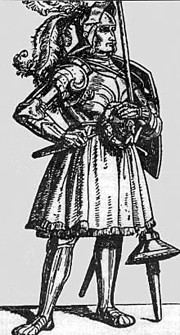
|
|
Though Charlemagne represented a brief retreat of the anti-Christian beliefs of the ancient Aryan pagan giants, the old Aryan "master race" philosophy soon returned, in the form of Emperor Maximilian. Maximilian took the rule over the old Holy Roman Empire in 1493, taking the rule by right of descent rather than election, as had been the custom up to that time. Maximilian appears to have been a throwback to the ancient giant Gomerian Cimbri who had proved to be such a challenge for the Romans, a badge that he wore with great pride. Standing at over eight feet tall, and having the extraordinary strength and physical attributes that have been the trademark of the giants, Maximilian indeed had reason to be proud.
He was tall, finely formed, with remarkably handsome features, clear blue eyes, and blond hair falling in ringlets upon his shoulders; he possessed great muscular strength, his body was developed by constant exercise and he was one of the boldest, bravest and most skillful knights of his day. But the giant's daring sometimes bordered on rashness — some described it as almost a madness — as when, for some examples, he 'followed a bear to his den, and fought him there; when he entered the lion's cage, and cowed him down; and, above all, when he chased the chamois and the wild-goat up to the highest peaks of the Tyrolese Alps.' In battle, Maximilian fought courageously. On many occasions, he proved himself to be a resourceful commander too, with a mind 'fertile in new devices and cunning modes of attack.' He also asked nothing of his men he himself would not do. Historians say that he even forged his own armor and tempered his own sword. Perhaps to give his horse a rest, the giant emperor often marched at the head of his men on foot, carrying an oversized lance on his shoulder. He further won the admiration of his soldiers for his ability 'not to be overcome by exertion and privation.'"18
Maximilian, like Maximinus, was a typical giant — superior size, strength, intelligence and skill, as well as natural leadership ability and a mind well-suited to warfare. However, there was an innate madness to the giant
homo artificialis
breed which often manifested itself in a suicidal fury, as shown by Maximilian's barehanded defeat of both a bear and a lion, as well as his hunting down of mountain goats unaided on the slippery slopes of the Tyrolese Alps.
Like
Og
of old, Maximilian was a true giant — a being of great power and beauty, who was also possessed of a dark side. Beautiful yet cruel, the giants considered themselves to be a master race, superior to all other forms of mankind.
And inherent to this sense of superiority was a need to prove this superiority, a test that they had been well equipped to fulfill. As such Maximilian, like his giant predecessors from ancient times, held to the racialist theory that they were superior to all other races. DeLoach explains,
Those who profess the Aryan theory hold that the Celtic race, particularly its Germanic branch, is vastly superior to all others. 'Only white peoples, especially the Celtic, possess true courage, love of liberty and the other passions and virtues which distinguish great souls,' proclaimed the German historian Christoph Meiners (1745-1810). Meiners is generally regarded as a founder of this racial theory. Julien-Joseph Virey (1775-1846), a disciple of Meiners, asks: "What would our world be without the Europeans? Powerful nations, a proud and and indomitable race, immortal geniuses in the arts and the sciences, a happy civilization. The European, called by his high destiny to rule the world, which he knows how to illumine with his intelligence and subdue with his courage, is the highest expression of man and at the head of the human race. The others, wretched horde of barbarians, are, so to say, no more than its embryo." In other words, the true Aryans see themselves as "supermen", and they regard "all the other species of men (for there are four or five different kinds) to be naturally inferior to the whites." All these peoples who are not light of skin and blond they classify as "subhumans".
Where did such an idea come from? In its earliest written form, the Aryan concept predates both Meiners and Virey. The historian S.H. Steinberg traced it back to the humanistic historiographers who lived during the reign of the Holy Roman Emperor Maximilian I (1493-1519). "It was these forefathers of our contemporary journalists who supplied the copy for Maximilian's anti-French propaganda," he writes. "The French and, in fact, every other nation were, so they argued, inferior to the Germans because of the latter's pride of place in the pedigree of the Western nations: had they not for ancestors the Cimbri who made Rome tremble?... Were the Germans of Maximilian not the sons and heirs of the Lombards who gave their name to Upper Italy, the Franks who established their rule over Gaul, the Angles and Saxons who made themselves masters of Britain?
19
With Emperor Maximilian came the beginning of the revival of the old Aryan race myth that had been propagated by the Gomerian giants in ancient times. Despite the fact that the Gomerian Celts, Gauls, Germani, and numerous other tribes of the giant descendants of Gomer had been soundly defeated by the homo sapiens Romans, they still held doggedly to the belief that they were superior to all other forms of mankind. This belief has survived even into modern times until it came to fruition again in the 20th century, in Hitler's Germany, where Hitler once again attempted to revive the ancient
herrenvolk,
or "master race" of the Germani.

Adolph Hitler, though a puny man of little consequence, rose to power over the most powerful war machine the world had ever seen to that point (in known history). But how did this failed artist and vagrant achieve this lofty goal? In fact, few know (or want to know) that Hitler was a committed
occultist,
who believed that he had been chosen by the gods of the ancient Aryans to resurrect the ancient Germani giants, and use them to conquer the world. Thus, though socially at the bottom rung of the ladder,
spiritually speaking
Hitler's situation was quite different.
Though on the face of it this concept seems ludicrous, as we have seen in Parts
I
II
and
III
of our series on giants, this same story, where the fallen angels had created the giants in ancient times in order to destroy God's own homo sapiens and conquer the world, has been repeating itself throughout human history. Hitler's Gemany, it seems, was only the latest in a series of attempts to revive the ancient
Nephilim
giants who had been destroyed by the Great Flood. The next generation of giants, the
Rephaim,
"those who were reborn", were an attempt to recapture the "glories" of the world before the Flood, of which Hitler's attempt was the most recent (However, it is not impossible that new attempts are ongoing as we speak). Thus, Hitler not only wanted to resurrect the ancient Germani giants, he wanted to resurrect the entire world as it had been before the Flood.
Hitler's aim was neither the founding of a race of supermen, nor the conquest of the world; these were only means towards the realization of the great work he dreamed of. His real aim was to perform an act of creation, a divine operation, the goal of a biological mutation which would result in an unprecedented exaltation of the human race and the "apparition of a new race of heroes and demigods and god-men." Perhaps these same neo-Nephilim Nazi "ubermen" are today clothed in the time and culture-appropriate sci-fi regalia of "alien"/human "hybrids" a la Whit Strieber, Harvard's Dr. John Mack, and a veritable cornucopia of other associated — often
Rockefeller-financed
— socio-cultural metaprogrammers.20
Though most would scoff at this, those same people are unaware that Hitler was a member of the occultic group
"The Thule Society",
which believed in the existence of an all-powerful being called "the Ubermensch", a powerful spiritual being that was in actuality a fallen angel. Some also believe that Hitler had willingly allowed himself to be possessed by this powerful fallen angel, which explains the enormous amount of charisma and personal magnetism this otherwise inconsequential man was able generate in order to bend the masses of Germany to his will. Hitler actually saw the Ubermensch, and even he was terrified by the cruel splendor of this being:
Hitler was talking one day to Rauschning, the Governor of Danzig, about the problem of a mutation of the human race. Rauschning, not possessing the key to such strange preoccupations, interpreted Hitler's remarks in terms of a stock-breeder interested in the amelioration of German blood.
"But all you can do," he replied, "is to assist Nature and shorten the road to be followed! It is Nature herself who must create for you a new species. Up till now the breeder has only rarely succeeded in developing mutations in animals — that is to say, creating himself new characteristics."
"The new man is living amongst us now! He is here!" exclaimed Hitler, triumphantly. "Isn't that enough for you? I will tell you a secret. I have seen the new man. He is intrepid and cruel. I was afraid of him." "In uttering these words," added Rauschning, "Hitler was trembling in a kind of ecstasy."
It was Rauschning, too, who related the following strange episode, about which Dr. Achille Delmas, a specialist in applied psychology, questioned him in vain: It is true that in a case like this psychology does not apply:
"A person close to Hitler told me that he wakes up in the night screaming and in convulsions. He calls for help, and appears to be half paralysed. He is seized with a panic that makes him tremble until the bed shakes. He utters confused and unintelligible sounds, gasping, as if on the point of suffocation. The same person described to me one of these fits, with details that I would refuse to believe had I not complete confidence in my
|
|
|
|
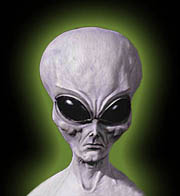
|
|
|
Azazel, the "Ubermensch", current spiritual ruler of the West, and nominally of the entire world. Not someone you want to wake up to.
|
informant. Hitler was standing up in his room, swaying and looking all round him as if he were lost. 'It's he, it's he,' he groaned, 'he's come for me!' His lips were white; he was sweating profusely. Suddenly he uttered a string of meaningless figures, then words and scraps of sentences. It was terrifying. He used strange expressions strung together in bizarre disorder. Then he relapsed again into silence, but his lips still continued to move. He was then given a friction and something to drink. Then suddenly he screamed: 'There! there! Over in the comer! He is there!' — all the time stamping with his feet and shouting. To quieten him he was assured that nothing extraordinary had happened, and finally he gradually calmed down. After that he slept for a long time and became normal again...."21
This strange episode clearly shows that Hitler was obsessed if not actually possessed by a powerful demon, which was most likely Azazel, the powerful
kosmokrator
demon that rules over the entire Earth. As we saw in
Part II
of our series on legendary Atlantis (which Hitler also believed in, by the way), Azazel is one of the two most powerful of the fallen angels who ruled the world before the Flood. These two had led the world into rebellion against God, and had created the
giants
to destroy the descendants of Adam. As a result, the God destroyed the giants with a Flood, and Azazel and Semjaza were punished by being imprisoned in the deep parts of the Earth, which we have theorized to be somewhere in the region of the Caucasus. These two powerful fallen angels, Azazel and Semjaza, though now their power is limited, still try to recreate the world before the Flood, and the giants they had created to conquer it. We further believe that Semjaza had taken control of the ancient Magogians and had used them to conquer the East, whereas Azazel had taken control of the Gomerians and had used them to conquer the West — repeating the pattern that they had originally initiated in the world before the Flood, a pattern of gross mismanagement that had led to the eventual destruction of
the antediluvian world.
Though these two powerful fallen angels are united in their opposition to God, it is important to note that these two demons only cooperate with each other out of necessity. It is most likely that they in fact struggle with God, but also with each for dominion over the Earth. Though they are united in their rebellion against God, as the ultimate self-centered individuals that they are, they also want to control each other, and the entire world, alone. It is this struggle between these two powerful arch demons, as well as struggles between the lesser demons under their sway, that has led to almost all the wars throughout our history. As such, we can see the patterns of the activities of these demons by tracking their "footsteps" throughout history, bloody footprints that have manifested themselved in the wars and conflicts of the human race. And the larger the war, the higher the level of conflict in the chain of demonic command, "world wars" being waged by the demon princes Azazel and Semjaza themselves.
As such, the leaders of the nations that wage world wars are most likely controlled by the kosmacrator (lit., "world ruling") demons that have initiated the wars in the first place. As we saw in
Part II,
both Hitler and Stalin led very much
parallel lives,
where both were involved in the secret societies and the occult, and both had invited demonic powers to control them in order to gain worldly power for themselves. And they were not disappointed, as it is likely that Hitler and Stalin were possessed by the most powerful demons of all, who used these men to fight out the greatest world war the world has ever seen (in known history).
Since
Hitler
was effectively in charge of the West, he must, therefore, have been possessed by Azazel, the demon prince of the West. Conversely Stalin, who effectively ruled over the East, must have been possessed by Semjaza, the demon prince of the East.22 Thus, World War II was essentially only the latest installment in the struggle between these two powerful demons over rulership of the Earth.
|
|

|
|
|
The "Jude" Star of David. The Nazis forced Jews in conquered countries to wear this "mark" during World War II. Azazel will have another "mark"
ready for those whom he has conquered in the aftermath of World War III.
|
|

However, though Azazel's enmity with Semjaza has been terrible and unending, Azazel's greatest enemy is the people of God, most particularly, the Jews. Many have indeed wondered why it was that Hitler attempted to exterminate the Jews, instead of merely deporting them, if he was so intent on maintaining the "purity" of the Germanic race. Indeed, his hatred for the Jews was far beyond mere anti-Semitism — there was definitely an evil spiritual power motivating him to go out of his way to try to destroy them. The answer, in the context that we have developed, is simple. The Jews and other Semitic peoples, who are basically mankind as God had intended,
pure descendants of Adam,
had intermarried with the remnants of the giants and other Japhethite peoples, effectively "normalizing" and greatly reducing the occurrence of the giant genes that remained from the Gomerian and other Celtic giants that had escaped slaughter by the Romans. As such, the Germanic and Celtic peoples had become smaller in stature, but much more civilized and amiable, to the point where they were able to settle down and create a great civilization. No longer wandering barbarians, seeking to conquer and destroy to fill the emptiness they felt inside, the interbreeding with the Jews and other Semites, along with the spiritual teachings that the Semites had retained from Noah and later prophets of God, had apparently given them the ability to love and show concern for the welfare of others, rather than only looking out for themselves. Charlemagne was a prime example of this type of "transformed man", who was able to rise above his own needs and instead put the needs of his neighbor ahead of his own. Without this philosophy, civilizations cannot be created, let alone maintained. Love, forgiveness, and putting the needs of others ahead of your own are the basis of all civilization, and as soon as these principles are removed, that civilization will crumble back into barbarism.
So it was that, as with all the giant invasions, the Gomerians were eventually worn down and bred out of existence, defeated in the relentless genetic arms race by sheer numbers. Now a combination of Japhethite and Semitic peoples (as well as some Hamitic), the European race as it is known today lived for thousands of years in a well-balanced and civil society, whose cultural achievements rival any that the world has ever seen. Even today, in post-Christian Europe, the old institutions and worldviews that were founded in the Christian era still keep European society from descending back into barbarism, despite their best attempts to remove Christendom and its institutions and replace it with sterile, futile socialism. However, whether their socialism is the aggressive national socialism of Hitler, or the passive, "democratic" socialism of 21st-century Europe, both will fail equally badly, and leave the Europeans wondering why they had enjoyed so many years of success, only to fail in the end. Having rejected God, all but exterminated His people in the past, and persecuting them in the present, Europe will once again fail to learn from history and look for a scapegoat for their failure. And once again, the Jews and their allies will be blamed for the failure of their fallen ideologies, and once again Azazel will move the peoples of Europe to exterminate his ancient enemy.

|
|

|
|
The next great war of Gog and Magog, as described in
Ezekiel 38-39,
where Gog and Magog and the Arab peoples band together in order to create a "final solution" for the Jews. The "white horseman" (let the reader understand) represents the forces of the Western Alliance, which will be made up of the U.S., Great Britain, Israel, Italy, Japan, Australia, New Zealand, and a number of other countries. "Gog" represents the forces of Europe, including France, Germany and other far left-wing socialist European countries. Europe may or not participate militarily, but they will almost certainly participate economically. "Magog" represents the forces of Russia and the Central Asian republics. From the south and west will come the remnant of the Arab and Islamic nations who are capable of competently waging war, including Egypt, Libya and the Sudan in the south, and Syria and possibly Turkey from the west. Jordan, Saudi Arabia, Yemen, and the lesser emirates will not get involved militarily. These forces of "Gog and Magog", or "the Eastern Axis", will be utterly destroyed, most likely by theater nuclear weapons, as conventional warfare against such a massive force would be impractical. This destruction will be condoned by God himself, described in Ezekiel as "fire from heaven".
|
This time, however, the persecution of the Jews will be instigated not only by Azazel, but also by Semjaza, who will also agitate his people to attempt to exterminate the Jews in concert with Azazel. Semjaza hates the people of God as much as does Azazel, as proven by the many pogroms Russian and Central Asian Jews and even some Christians have had to endure at the hands of the Russians and their allies. Once again, probably very soon Azazel, who rules over Gog, will join forces with Semjaza, who rules over Magog in a final attempt to destroy the Jews, as it is written in the Book of Ezekiel:
1 The word of the LORD came to me:
2 "Son of man, set your face against Gog, of the land of Magog, the chief prince of Meshech and Tubal; prophesy against him
3 and say: 'This is what the Sovereign LORD says: I am against you, O Gog, chief prince of Meshech and Tubal.
4 I will turn you around, put hooks in your jaws and bring you out with your whole army-your horses, your horsemen fully armed, and a great horde with large and small shields, all of them brandishing their swords.
5 Persia, Cush and Put will be with them, all with shields and helmets,
6 also Gomer with all its troops, and Beth Togarmah from the far north with all its troops-the many nations with you.
7 " 'Get ready; be prepared, you and all the hordes gathered about you, and take command of them.
8 After many days you will be called to arms. In future years you will invade a land that has recovered from war, whose people were gathered from many nations to the mountains of Israel, which had long been desolate. They had been brought out from the nations, and now all of them live in safety.
9 You and all your troops and the many nations with you will go up, advancing like a storm; you will be like a cloud covering the land.
10 " 'This is what the Sovereign LORD says: On that day thoughts will come into your mind and you will devise an evil scheme.
11 You will say, "I will invade a land of unwalled villages; I will attack a peaceful and unsuspecting people-all of them living without walls and without gates and bars.
12 I will plunder and loot and turn my hand against the resettled ruins and the people gathered from the nations, rich in livestock and goods, living at the center of the land."
13 Sheba and Dedan and the merchants of Tarshish and all her villages will say to you, "Have you come to plunder? Have you gathered your hordes to loot, to carry off silver and gold, to take away livestock and goods and to seize much plunder?" '
14 "Therefore, son of man, prophesy and say to Gog: 'This is what the Sovereign LORD says: In that day, when my people Israel are living in safety, will you not take notice of it?
15 You will come from your place in the far north, you and many nations with you, all of them riding on horses, a great horde, a mighty army.
16 You will advance against my people Israel like a cloud that covers the land. In days to come, O Gog, I will bring you against my land, so that the nations may know me when I show myself holy through you before their eyes.
17 " 'This is what the Sovereign LORD says: Are you not the one I spoke of in former days by my servants the prophets of Israel? At that time they prophesied for years that I would bring you against them.
18 This is what will happen in that day: When Gog attacks the land of Israel, my hot anger will be aroused, declares the Sovereign LORD.
19 In my zeal and fiery wrath I declare that at that time there shall be a great earthquake in the land of Israel.
20 The fish of the sea, the birds of the air, the beasts of the field, every creature that moves along the ground, and all the people on the face of the earth will tremble at my presence. The mountains will be overturned, the cliffs will crumble and every wall will fall to the ground.
21 I will summon a sword against Gog on all my mountains, declares the Sovereign LORD . Every man's sword will be against his brother.
22 I will execute judgment upon him with plague and bloodshed; I will pour down torrents of rain, hailstones and burning sulfur on him and on his troops and on the many nations with him.
23 And so I will show my greatness and my holiness, and I will make myself known in the sight of many nations. Then they will know that I am the LORD.' (
Ezekiel 38)
The phrase, "Gog of the land of Magog" is interesting, as it implies that Gog and Magog, hereditary enemies, will be as one in a huge war that will involve most of Europe and Asia. Current trends in geopolitics appear to support this likelihood, as the socialist Germans and the unmitigated Gauls invoke more and more anti-Western rhetoric, and continue to align themselves with a resurgent Communist Russia. This may be what Ezekiel meant by "Gog of the land of Magog" — the leaders of Europe, though located in the hereditary lands of Gog, are politically Communist, and in this way they are "of the land of Magog". God will take this group of Communist and Socialist nations and "turn them around", pointing them back at their point of origin in the Middle East, from where Gomer and Magog had originally emigrated over 10,000 years ago. But this return will not be for peace, but for war, as the warlike tendencies of these people once again come to the fore, and they ally themselves with Iran, Syria, Turkey, Egypt, Libya, and the Sudan in one last attempt to destroy Israel.
This vast mongrel horde will have but one objective — to destroy the Jews once and for all, and anyone who is allied with them. It is important to note that this prophecy can only take place after AD 1948, as the land of Israel, "a land that has been recovered from war, whose people were gathered from many nations to the mountains of Israel" had ceased to exist after the Romans had sacked Jerusalem in AD 70. Scattered among the nations for close to 1,900 years, only in the last 50 years or so has the prophecy of Ezekiel been able to be fulfilled. Moreover, interestingly, a "wall" or "fence" has just recently been created by the Israelis in order to keep out Palestinian terrorists. In fact, it is a major point of contention that has been holding up the Middle East peace process. However, with Arafat dead, and with the Middle East peace process in the balance, the Israelis will trade that fence for peace, and Ezekiel's prophecy that Israel will become "a land of unwalled villages" will be fulfilled.
In summary, this "Eastern Axis" will seek to despoil and destroy Israel, with the intent of ridding themselves of their ancient enemies and enriching themselves in the process. Unfortunately for them, Israel is not only quite capable of defending itself, but as part of the Western Alliance, it will be part of a military force that is far superior to that of Gog and Magog. Seeking to overwhelm the Western Alliance with sheer numbers, the Eastern Axis will be met with nuclear counterforce, "torrents of rain, hailstones and burning sulfur", and almost all of the invading force will be annihilated. In this way will the giants Gog and Magog, the ancient enemies of God, meet their doom.




Though Gog and Magog will meet their doom in the Middle East, not all of the giants in the Earth live in Europe and Asia. As we have seen, many of the giants of Europe and Asia had left their ancestral homelands and emigrated across the seas to conquer
America.
It could well be that the most powerful, aggressive, intelligent, and dangerous of the giants had emigrated to America in times past, and recently, taking with them the fiery torch of technology that Prometheus/Azazel had stolen from heaven and given to mankind. And though the giants are now diminished in stature, their intelligence and ambition are still limitless, and their hunger for power, unquenchable. It may be here, in America, that the giants in the Earth will make their last stand, and from here, conquer the entire world.
Though Europe and Russia have had warlike pasts, by far the most militarily powerful country the post-diluvian world has ever seen is the United States. With our wonder weapons, the likes of which have not been seen since the drowning of the antediluvian world, America is quite capable of taking on the entire world right now. Such super-advanced technology could only have come from Azazel, the fallen angel who instructed mankind in how to make advanced weapons of war in the world before the Flood, weapons that led to wars that polluted Earth so badly that the Flood was necessary simply to keep it habitable. It may well be that Azazel has abandoned Europe and instead chosen America as the means through which he will attempt to conquer the world. This may be the true meaning of the phrase, "Gog of the land of Magog" — all of Europe and Central Asia are currently under the control of Semjaza. However, it is becoming increasingly clear that Azazel intends to use the United States to finally defeat Semjaza and his associates, and conquer not only Europe and Russia, but also the Middle East, Asia and, for a time, even the entire world.
As we saw in
The Grand Canyon Part II,
there is a Hopi prophecy that, at the end of the Fourth Age, Masaw, the caretaker of the Earth will be given control of the Earth. This will be necessary as mankind will have once again abandoned the laws of the Creator, and will have fallen into anarchy, requiring a firm hand in order to restore
the balance.
Masaw's throne in the Hopi myth was, of course, in the Desert Southwest region of America, the Hopi "center of the universe", from whence he will rise again near the end of the Fourth Age. It may well be that Masaw is the same kosmokrator demon known in the Bible and the Book of Enoch as "Azazel", the prince of this world. If so, the Desert Southwest, or the American West in general, may be the seat of the next great world empire, an empire unlike all the rest that have come before.
There were giants in the Earth in those days ... and also afterwards. 

Part I: Giants of the Ancient Near East
|
Part II: Giants of the Americas
Part III: Giants of Asia
Gog, Prince of the West
|
Giants of Europe
|
The Coming War of Gog and Magog
Hunting for Giants
|
Giant Links
|
Books
|
Audio
|
Video
|
Posters
Editorial
|
Press Releases
|
Book Reviews
|
Fragments
NEW! Artifacts: Coral Castle
Grand Canyon II
|
Giants IV
|
Osiria IV
Register
for our Hall of Records Newsletter!
Questions? Comments? Suggestions? Advertising? Press Releases?
Contact us!

1
Charles DeLoach, "Giants Who Became Gods", in
Giants: A Reference Guide from History, the Bible, and Recorded Legend
(Metuchen, NJ: The Scarecrow Press, Inc., 1995), 110-112.
2
DeLoach, "Giants Who Became Gods", 112.
3
DeLoach, "Giants Who Became Gods", 113-114.
4
DeLoach, "Giants Who Became Gods", 118-119.
5
Vassil Karloukovski, "The Cimmerians"
(Great Bulgaria: http://members.tripod.com/great-bulgaria/).
6
DeLoach, "Gomarian Giants", 133.
7
DeLoach, "Celtic Giants", 53.
8
DeLoach, "Celtic Giants", 54-55.
9
DeLoach, "Celtic Giants", 56-57.
10
DeLoach, "Rome vs. Senone Giants", 249-251.
11
DeLoach, "German Giants' Annihilation", 96.
12
DeLoach, "German Giants' Annihilation", 96-97.
13
DeLoach, "German Giants' Annihilation", 101-102.
14
DeLoach, "Maximinus", 186.
15
DeLoach, "Maximinus", 190.
16
Robin Chew, "Charlemagne: King of the Franks and Emperor of the Holy Roman Empire"
(Lucidcafe: http://www.lucidcafe.com).
17
DeLoach, "Charlemagne", 62.
18
DeLoach, "Maximilian", 183.
19
DeLoach, "Maximilian", 180-181.
20
"Adolf Hitler und die Ubermensch von der Golden Dawn"
(Forumer: http://forumer.com).
21
"Adolf Hitler und die Ubermensch von der Golden Dawn".
22
cf. Mysterious World, "Giants of the Americas"
(Mysterious World: http://mysteriousworld.com). This ancient conflict between Semjaza and Azazel is also alluded to in Daniel 10:12-20.




 SilkRoad.com: Silk Road Chronology
SilkRoad.com: Silk Road Chronology
 The Cimmerians
The Cimmerians
 Livius: Cimmerians
Livius: Cimmerians
 Livius: Scythians/Sacae
Livius: Scythians/Sacae
 SilkRoad.com: The Scythians
SilkRoad.com: The Scythians
 SilkRoad.com: The White Huns - The Hephthalites
SilkRoad.com: The White Huns - The Hephthalites
 Livius: Arians
Livius: Arians
 Tobolsk, CIS And Baltic Political Geography
Tobolsk, CIS And Baltic Political Geography
 Wikipedia: Kurgan
Wikipedia: Kurgan
 Proto-Indo-European and Indo-Europeans
Proto-Indo-European and Indo-Europeans
 Indo-European Language Tree: Centum Languages (Western/X1 Branch)
Indo-European Language Tree: Centum Languages (Western/X1 Branch)
 Indo-European Language Tree: Satem Languages (Eastern/X2 Branch)
Indo-European Language Tree: Satem Languages (Eastern/X2 Branch)
 A. Richard Diebold Center for Indo-European Language and Culture
A. Richard Diebold Center for Indo-European Language and Culture
 A. Richard Diebold Center for Indo-European Language and Culture: The Indo-European Language Family
A. Richard Diebold Center for Indo-European Language and Culture: The Indo-European Language Family
 The Early History of Indo-European Languages
The Early History of Indo-European Languages
 The Rosetta Project: Indo-European Languages
The Rosetta Project: Indo-European Languages
 Gog and Magog
Gog and Magog
 The Legend of Gog and Magog
The Legend of Gog and Magog
 Gog and Magog
Gog and Magog
 Chuck Missler: "The Magog Identity"
Chuck Missler: "The Magog Identity"
 AC Russia Invades Israel
AC Russia Invades Israel

 Giants
Giants
David Larkin, Julek Heller (Illustrator)
Rating:     
Giants is a classic popular reference work on the subject of giants in myth and history, and is also an enjoyable read on its own. Filled with lavish, cleverly rendered illustrations, it makes an excellent general reference book and even a good coffee table book. (Review by Mysterious World)
Click
here
to buy this book.
 Genesis 6 Giants
Genesis 6 Giants
Stephen Quayle
Rating:   
Genesis 6 Giants provides a good, solid overview of giants in religion, myth and history, and also serves as a good reference for other sources on giants. Quayle also adds his own insights into the mix, providing some interesting and thought-provoking reading. He also offers several other books on related topics on his website,
http://www.stevequayle.com.
(Review by Mysterious World)
Click
here
to buy this book.
 Giants: A Reference Guide from History, the Bible, and Recorded Legend
Giants: A Reference Guide from History, the Bible, and Recorded Legend
Charles DeLoach
Rating:    
A standard reference book for giants throughout history, DeLoach's classic work is the result of years of painstaking research. Books of this type are becoming increasingly rare, but fortunately, DeLoach's Giants is still in print, or else much important information on this subject would be lost, or very difficult to find. (Review by Mysterious World)
Click
here
to buy this book.
 The World of the Celts
The World of the Celts
Simon James
Rating:     
"The whole race... is madly fond of war, high-spirited and quick to battle... and on whatever pretext you stir them up, you will have them ready to face danger, even if they have nothing on their own side but their own strength and courage" - Strabo, first century BC. Warlike, flamboyant, courageous - the ancient Celts had a fearsome reputation, even among the bellicose Romans. For 500 years they dominated the barbarian lands north of the Alps, before being largely absorbed into the Roman Empire. But Celtic culture survived and achieved a glorious flowering in the post-Roman, early Christian era. Today Celtic influence can be found everywhere, in arts and crafts, in legends, in placenames and even in the languages we speak. In this new introduction to the world of the Celts, Simon James looks at all aspects of their history. Individual sections chart their rise, their way of life from farming to feasting, their wars, their gods, and their superb craftsmanship. Also highlighted are the hitherto neglected subject of Celtic life under Roman rule and persistent traditions that led to the Celtic renaissance in Ireland after AD 400. Original features include the latest discoveries; extracts from classical authors; illustrated retellings of the most famous myths and legends; tables of comparative information; diagrams, maps and site plans. The Celts once held sway over much of Europe, from Caledonia to Asia Minor. Here is the whole story of this immensely inventive and influential people. (Review by Amazon.com)
Click
here
to buy this book.
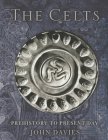 The Celts
The Celts
John Davies
Rating:    
This is an account of the Celtic peoples exploring the cultural, archaeological and historical evidence for their origins, development and heritage. From their heyday to their defeat by the Romans, from their adoption of Christianity to the flourishing of the Celtic church. The span of this exploration extends from prehistoric Europe to near-obliteration to a new self-assertion as we enter a new millennium.
(Review by Amazon.co.uk)
Click
here
to buy this book.
 Germanic Warrior: Ad 236-568 (Warrior Series, 17)
Germanic Warrior: Ad 236-568 (Warrior Series, 17)
Simon MacDowall, Angus McBride (Illustrator)
Rating:    
70 b/w, 14 color 7 x 9 Trade edition of Warrior 17 The Germanic warrior was perhaps the most important player in the process of evolution from classical to feudal society. By no means a united people, a tenuous, shared language root was perhaps all that these diverse tribes had in common. This volume is offers an overview of the motivations, lifestyles and evolution of these fascinating peoples, looking at how individual soldiers lived and fought.
(Review by Amazon.com)
Click
here
to buy this book.
 Celtic Warrior (Men at Arms Series, 30)
Celtic Warrior (Men at Arms Series, 30)
Stephen Allen
Rating:    
In the 1st Century BC, Strabo wrote of the Celts: 'The whole race...is madly fond of war, high -spirited and quick to battle...and on whatever pretext you stir them up, you will have them ready to face danger, even if they have nothing on their side but their own strength and courage'. This book gives an insight into the life of the Celtic warrior, and his experience of battle - on fact, on horseback, and as a charioteer. It also details Celtic society and studies the vital ritual nature of Celtic warfare, from the naked gaesatae to the woad-painted warriors.
(Review by Amazon.com)
Click
here
to buy this book.
 The Vikings (Men at Arms Series, 3)
The Vikings (Men at Arms Series, 3)
Ian Heath
Rating:    
From the late 8th century, the Vikings were to play a major role in the history of every nation from Ireland to Russia. These raiders from the sea were called al-Madjus "heathen wizards" in Spain, they established the dukedom of Normandy, provided the Byzantine Emperors bodyguard and landed on the shores of America 500 years before Columbus.
(Review by Amazon.com)
Click
here
to buy this book.
 Anglo-Saxon Thegn: 449-1066 AD (Men at Arms Series, 5)
Anglo-Saxon Thegn: 449-1066 AD (Men at Arms Series, 5)
Mark Harrison, Gerry Embleton
Rating:    
This volume reveals the development of the Saxon warrior, his weapons, armour, tactics and training and his domination of the British Isles until the Norman conquest of 1066.
(Review by Amazon.com)
Click
here
to buy this book.
 Archaeology and Language : The Puzzle of Indo-European Origins
Archaeology and Language : The Puzzle of Indo-European Origins
Colin Renfrew
Rating:     
In this book Colin Renfrew directs remarkable new light on the links between archaeology and language, looking specifically at the puzzling similarities that are apparent across the Indo-European family of ancient languages, from Anatolia and Ancient Persia, across Europe and the Indian subcontinent, to regions as remote as Sinkiang in China. Professor Renfrew initiates an original synthesis between modern historical linguistics and the new archaeology of cultural process, boldly proclaiming that it is time to reconsider questions of language origins and what they imply about ethnic affiliation--issues seriously discredited by the racial theorists of the 1920s and 1930s and, as a result, largely neglected since. Challenging many familiar beliefs, he comes to a new and persuasive conclusion: that primitive forms of the Indo-European language were spoken across Europe some thousands of years earlier than has previously been assumed. There was, in particular, no "coming of the Celts", but rather a parallel development of Celtic-speaking peoples in much the same areas in which they are found today.
(Review by Amazon.com)
Click
here
to buy this book.
 In Search of the Indo-Europeans: Language, Archaeology, and Myth
In Search of the Indo-Europeans: Language, Archaeology, and Myth
J. P. Mallory
Rating:     
What image do the Indo-Europeans conjure up? For many, it is one of horse-riding warriors sweeping out of Asia, spreading their languages and culture with each clash of the sword. Certainly, linguistic history shows that most of the peoples of Europe, Iran and India share a common ancient language known as Proto-Indo-European. Celts, Germans, Italians, Greeks, Albanians, Slavs, Indians and many peoples long extinct can all have their linguistic ancestry traced back to this mother tongue. But how far does the story told by languages match the historical and archaeological record? What do we know about the lives and beliefs of these early Indo-Europeans? And where was their original homeland? With the skill of a forensic scientist Dr. Mallory traces the immediate origins of each of the Indo-European peoples of Europe and Asia. By comparing their languages he demonstrates their common cultural heritage, and through the technique of comparative mythology he examines their earliest beliefs. Then he puts the case for their most likely homeland and presents the archaeological and linguistic evidence for their expansion across Europe and Asia, a process that has in recent times carried Indo-European speakers to every corner of the world. Accompanied by extensive quotations from translated texts and fully illustrated with maps, diagrams and photographs, In Search of the Indo-Europeans is recognized as the standard work in its field.
(Review from the back cover)
Click
here
to buy this book.
 Update on the Aryan Invasion Debate
Update on the Aryan Invasion Debate
Koenraad Elst
Rating:     
The author shows profound knowledge of the highly political debate on the Aryan Invasion theory. Though the Aryan Invasion Theory is untenable based on current data he urges the revisionist scholars to answer some of the valid concerns about the Indian Urheimat Theory (IUT). He laments on the deafness and over confidance of the scholars in each camp. There is a good discussion of the linguistic issues for the uninitiated. The book draws the reader in right from the first page and is hard to put down. (Review by Amazon.com)
Click
here
to buy this book.
 Genes, Peoples, and Languages
Genes, Peoples, and Languages
Luigi Luca Cavalli-Sforza, Mark Seielstad
Rating:     
Luigi Luca Cavalli-Sforza was among the first to ask whether the genes of modern populations contain a historical record of the human species. Cavalli-Sforza and others have answered this question-anticipated by Darwin-with a decisive yes. Genes, Peoples, and Languages comprises five lectures that serve as a summation of the author's work over several decades, the goal of which has been nothing less than tracking the past hundred thousand years of human evolution.
Cavalli-Sforza raises questions that have serious political, social, and scientific import: When and where did we evolve? How have human societies spread across the continents? How have cultural innovations affected the growth and spread of populations? What is the connection between genes and languages? Always provocative and often astonishing, Cavalli-Sforza explains why there is no genetic basis for racial classification.
(Review by Amazon.com)
Click
here
 Hitler and Stalin: Parallel Lives
Hitler and Stalin: Parallel Lives
Alan Bullock
Rating:     
This is a huge and masterful dual biography of two of the most monstrous personalities of this century. Bullock, whose Hitler: A Study in Tyranny ( LJ 2/15/64) truly deserves its designation as a classic, has produced a smoothly written study of how these two lives ran parallel and how they intertwined to affect the lives of millions in the first half of this century. One would expect Bullock to know Hitler, but his grasp of Stalin and his times is also impressive. In chapters alternately dealing with Hitler and then Stalin, Bullock analyzes how each man achieved and then used power for his own twisted goals. It is chilling to realize that both men rose within legitimate institutions, each "playing the game" by the established rules. Hitler's evil empire collapsed with his death, Stalin's would live on to haunt the Soviet Union for decades. Essential for anyone seeking to understand the history of the West in this century.
(Review by Library Journal)
Click
here
to buy this book.

 Twilight of the Gods
Twilight of the Gods
Richard Wagner
Rating:
    
If you like your Wagner served up in bleeding chunks or if you're simply in a hurry to hear the tunes, then this compilation is for you. The performances, drawn from the Polygram (mainly Deutsche Grammophon) back catalog, are for the most part authoritative. They feature the likes of Herbert von Karajan, with the Berlin Philharmonic, and Karl B�hm, with the Bayreuth Festival Orchestra (and chorus), in extracts from recordings of complete operas, and conductors Giuseppe Sinopoli, Otto Gerdes, and Antal Dor�ti in some of the more familiar overtures and preludes. Singing, without which it is impossible to get the full flavor of Wagner's work, is skirted whenever possible: this is an unapologetic tribute to Wagner the orchestral genius. At times the salesmanship is a little overblown — the glitzy packaging includes a cover shot of the helicopters from Apocalypse Now — and the sound, some of it from very good originals, seems to have been juiced with a little added digital reverb, resulting in an overall glassiness. The gaps between tracks are minimized, disco style, so there's no dead air, and the whole thing has an Entertainment Tonight feel to it. Were he around, Wagner would have screamed bloody murder, then happily taken his cut of the action. For today's on-the-go listener, this may well be the most practical way to enjoy Wagner's music, but we won't be happy until it motivates at least one newcomer to seek out a recording of a complete opera. Anyone who does that will find out what "apocalypse" really means.
(Review by Amazon.com)
Click
here
to buy this CD.
 Conan The Barbarian: Original Motion Picture Soundtrack
Conan The Barbarian: Original Motion Picture Soundtrack
Basil Poledouris
Rating:
   
From the time between when the oceans drank Atlantis, and the rise of the sons of Aryas, came a soundtrack undreamt of. This Varese Sarebande version of the CD differs from the import in that it contains several more songs — well worth the price if you are as much a fan of Conan as are we. What is best in life? Listening to this CD while weaving tales of gods, warriors, witches ... and giants!
(Review by Mysterious World)
Click
here
to buy this CD.
 Dances With Wolves: Original Motion Picture Soundtrack
Dances With Wolves: Original Motion Picture Soundtrack
John Barry
Rating:
    
John Barry's Academy Award-winning score for actor/director Kevin Costner's nouveau western, Dances with Wolves, is nothing short of a modern classic by a film scoring master. Utilizing Wagnerian structure, Barry's three main themes recur in magisterial symphonic form. The memorable "John Dunbar" theme alone has become an almost subconscious part of modern life, utilized as Muzak and underscore for public events great and small. Barry's skills as an arranger color his themes in subtly shifting orchestral hues, giving even the most repeated melodic passages new emotional weight. Barry's rich music is living proof that the art of orchestral film scoring is still alive and surprisingly vital in the '90s.
(Review by Amazon.com)
Click
here
to buy this CD.
 Long Walk Home: Music from the Rabbit-Proof Fence [SOUNDTRACK]
Long Walk Home: Music from the Rabbit-Proof Fence [SOUNDTRACK]
Peter Gabriel
Rating:
   
Though originally written for the film "Rabbit-Proof Fence", set in aboriginal Australia, the primeval and mysterious passions of this aborigine-inspired music brings to mind the idea of a ancient race whose time has passed. While the booming electro-tribal rhythms of previous Gabriel work come instantly into play, there's a sense of spacious mystery that's perfectly emblematic of the story's Australian outback setting. Gabriel's penchant for dense aural construction gives way to an ambient soundscape punctuated by Aboriginal percussion, didgeridoo, and bird song, and occasionally washed over by lolling tides of synth and samples. It's an atmosphere that, like the Aboriginal world it evokes, is nearly devoid of traditional melody, but one infused with a gripping, almost subliminal power.
(Review by Mysterious World)
Click
here
to buy this CD.

 Mysterious Origins of Man: Rewriting Man's History
Mysterious Origins of Man: Rewriting Man's History
(1999)
Rating:
   
On February 25, 1996 NBC aired a one-hour prime-time special, The Mysterious Origins of Man, hosted by Charlton Heston. Controversy exploded in the academic community following this telecast. Much of the material for the program was taken from Forbidden Archeology, featuring interviews with co-authors Michael Cremo and Richard Thompson on the show. This DVD provides explosive evidence of man's true history, a history that academics don't want you to know about.
(Review by Mysterious World)
Click
here
to buy this DVD.
 Conan the Barbarian - Collector's Edition
Conan the Barbarian - Collector's Edition
(1982)
Rating:
   
Conan the Barbarian, the movie that turned Arnold Schwarzenegger into a global superstar, is a prime example of a match made in heaven. It's the movie that macho maverick writer-director John Milius was born to make, and Arnold was genetically engineered for his role as the muscle-bound, angst-ridden hero created in Robert E. Howard's pulp novels. Oliver Stone contributed to Milius's screenplay, and the production design by comic artist Ron Cobb represents a perfect cinematic realization of Howard's fantasy world. To avenge the murder of his parents, Conan tracks down the evil Thulsa Doom (James Earl Jones) with the help of Queen Valeria (played by buff B-movie vixen Sandahl Bergman) and Subotai the Mongol (Gerry Lopez). Aptly described by critic Roger Ebert as "the perfect fantasy for the alienated pre-adolescent," this blockbuster is just as enjoyable for adults who haven't lost their youthful imagination.
(Review by Amazon.com)
Click
here
to buy this DVD.
 The Celts - Rich Traditions & Ancient Myths
The Celts - Rich Traditions & Ancient Myths
(1987)
Rating:
   
The Celts gave Enya her first popular showcase, but there's far more to this epic documentary series than lushly ethereal music. Produced by BBC Scotland in 1987, the six-part, six-hour series shows its age with simple graphics and visual design, but writer-narrator Frank Delaney compensates with thorough scholarship and engaging presentation. "The Man with the Golden Shoes" begins with the Celts' earliest origins in Austria, studying burial remains to reveal a fiercely independent people, driven to expansion and exploration but failing to unite against the dominant forces of Rome. Subsequent episodes follow a categorical approach to Celtic history: "The Rise of Nations" in the British Isles leads to Celtic strongholds in Wales, Scotland, Ireland, and Brittany; "A Pagan Trinity" surveys Celtic mythology and the transition (through cultural cross-pollination) from Druid priesthoods to Celtic-influenced Christian missionaries; "The Open-Ended Curve" illuminates the development of Celtic art, music, and literature; "The Final Conflict" explores the fading, and subsequent revival, of Celtic languages, and how this history is reflected in present-day (and often erroneous) definitions of "Celtic"; and "The Legacy" examines the tenacious efforts to preserve Celtic language and culture in modern society.
(Review by Amazon.com)
Click
here
to buy this DVD.
 Apocalypse Now
Apocalypse Now
(1979)
Rating:
   
In the tradition of such obsessively driven directors as Erich von Stroheim and Werner Herzog, Francis Ford Coppola approached the production of Apocalypse Now as if it were his own epic mission into the heart of darkness. On location in the storm-ravaged Philippines, he quite literally went mad as the project threatened to devour him in a vortex of creative despair, but from this insanity came one of the greatest films ever made. It began as a John Milius screenplay, transposing Joseph Conrad's classic story "Heart of Darkness" into the horrors of the Vietnam War, following a battle-weary Captain Willard (Martin Sheen) on a secret upriver mission to find and execute the renegade Colonel Kurtz (Marlon Brando), who has reverted to a state of murderous and mystical insanity. The journey is fraught with danger involving wartime action on epic and intimate scales. One measure of the film's awesome visceral impact is the number of sequences, images, and lines of dialogue that have literally burned themselves into our cinematic consciousness, from the Wagnerian strike of helicopter gunships on a Vietnamese village to the brutal murder of stowaways on a peasant sampan and the unflinching fearlessness of the surfing warrior Lieutenant Colonel Kilgore (Robert Duvall), who speaks lovingly of "the smell of napalm in the morning." Like Herzog's Aguirre: The Wrath of God, this film is the product of genius cast into a pit of hell and emerging, phoenix-like, in triumph. Coppola's obsession (effectively detailed in the riveting documentary Hearts of Darkness, directed by Coppola's wife, Eleanor) informs every scene and every frame, and the result is a film for the ages.
(Review by Amazon.com)
Click
here
to buy this DVD.


 Ireland - The Giant's Causeway
Ireland - The Giant's Causeway
Size: 13 in x 38 in
Rating:
   
The world-famous Giant's Causeway, located on the northern coast of Ireland. The causeway, a mass of hexagonal columns created by rapidly cooling volcanic basalt, the causeway has been a prominent part of Irish myth and legend for thousands of years. (Review by Mysterious World)
Click
here
to buy this poster.
Editorial
|
Press Releases
|
Book Reviews
|
Fragments
NEW! Artifacts: Coral Castle
Grand Canyon II
|
Giants IV
|
Osiria IV
Register
for our Hall of Records Newsletter!
Questions? Comments? Suggestions? Advertising? Press Releases?
Contact us!
|
